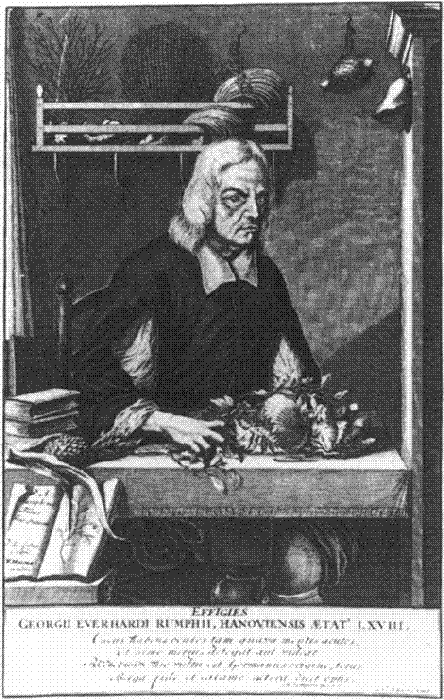
Georg Everhard Rumphius (?1628-1702). Photo Letterkundig Museum, The Hague.
(1628-1702) lived on the island of Amboyna in the Moluccas, where he served as
voc-merchant, administrator, soldier and judge. Rumphius was an accomplished mathematician and engineer, draughtsman and historian. Blind since about 1670, he was as multilingual as the
Hobson-Jobson dictionary of 1886, which includes amongst its sources his 7-volume
Herbarium Amboinense of 1741.
The other book of this Pliny of the Indies, The Ambonese Curiosity Cabinet, originally published in 1705, has now been translated into English and published in a beautiful scholarly edition by E.M. Beekman. It is a book about the shells of the Moluccas, in three parts: first the Soft shellfish, in 44 chapters, with 16 plates; then the Hard shellfish, in 39 chapters, with 33 plates; and finally the Minerals, Stones and Other Rare Things such as gold, amber, precious stones, snakes and whales, in 87 chapters with 11 plates. The book is published with all the original engravings, though not the frontispiece of 1705. Beekman has added a solid 70-page introduction on Rumphius' life and work, and some 160 pages of annotations and references which bear witness to his extraordinary erudition and scholarship.
Rumphius' book was inspired by a religious desire to read and understand God's book of nature. At the same time it reflects the interest in discovery, description and classification that is characteristic of early modern natural science. His descriptions offer careful and precise accounts of the shapes and colours of the shells of the East Indies, where and when they can be found, what they are used for and what medicinal properties they have, how to clean them and keep them or eat them. The book resounds with the delights of language and naming, in Dutch, English, Latin, French, Italian, Greek, Portuguese, Malay, Ambonese and at times also in Chinese and Arabic. It is full of local lore and legend, such as the tale of the Coral Woman hauled from the sea in Ambon Bay in 1681. Of the Marble Whelks, Rumphius tells us that they ‘are eagerly sought after for making rings, which are worn on the fingers not only by the Native women, but by our women as well’, and then proceeds to explain how these rings were made.
Later, the Moluccas' incredible riches in shells were mentioned by Darwin's friend, the explorer Alfred Russell Wallace, in his book The Malay Archipelago (1869). He recounts how in January 1858 he had gone ‘by invitation, to see a collection of shells and fish made by a gentleman of Amboyna’, containing - at a rough estimate - ‘nearly a thousand different kinds of shells, and perhaps ten thousand specimens’. But Wallace and Darwin did not know the works of Rumphius. It was their American contemporary, the naturalist A.S. Bickmore, who in 1868 travelled to the Moluccas with a copy of The Ambonese Curiosity Cabinet, and found the shells and stones there almost exactly as Rumphius had described them two centuries before. A scientific expedition in the early 1990s again confirmed the accuracy of Rumphius' descriptions.
For this English translation, Beekman has used the English and Low-Dutch Dictionary by William Sewell, published in Amsterdam in 1691. While he has retained the original Malay names and the Latin names of modern scientific terminology, Beekman has largely discarded the Dutch ones which Rumphius gave - thus losing the poetic quality and the Adamic force of names such as ‘Droomhorentje’ (Little Dream Horn), ‘Prinsenbegrafenis’ (Prince's Funeral), or ‘Wilde Boerenmuziek’ (Peasant Music). The few that have been retained, such as ‘Kinkhooren’ (Whelk) on p. 134, are not included in the index.
Published two hundred years after the demise of the voc in 1799, this majestic English edition by Beekman testifies to the continuing fascination of Rumphius' work. Here it is worth noting a remarkable tradition of women's knowledge of the secrets of nature. This is hinted at in Beekman's dedication of the book, ‘For Faith: my Susanna’, which refers to Rumphius' first wife, the native woman Susanna, who knew and shared with him her knowledge of tropical nature and the local lore and legend pertaining to it. In Beekman's earlier anthology of Rumphius' nature writings, The Poison Tree (1981), there is an illustrated description of the orchid which Rumphius named Flos Susannae